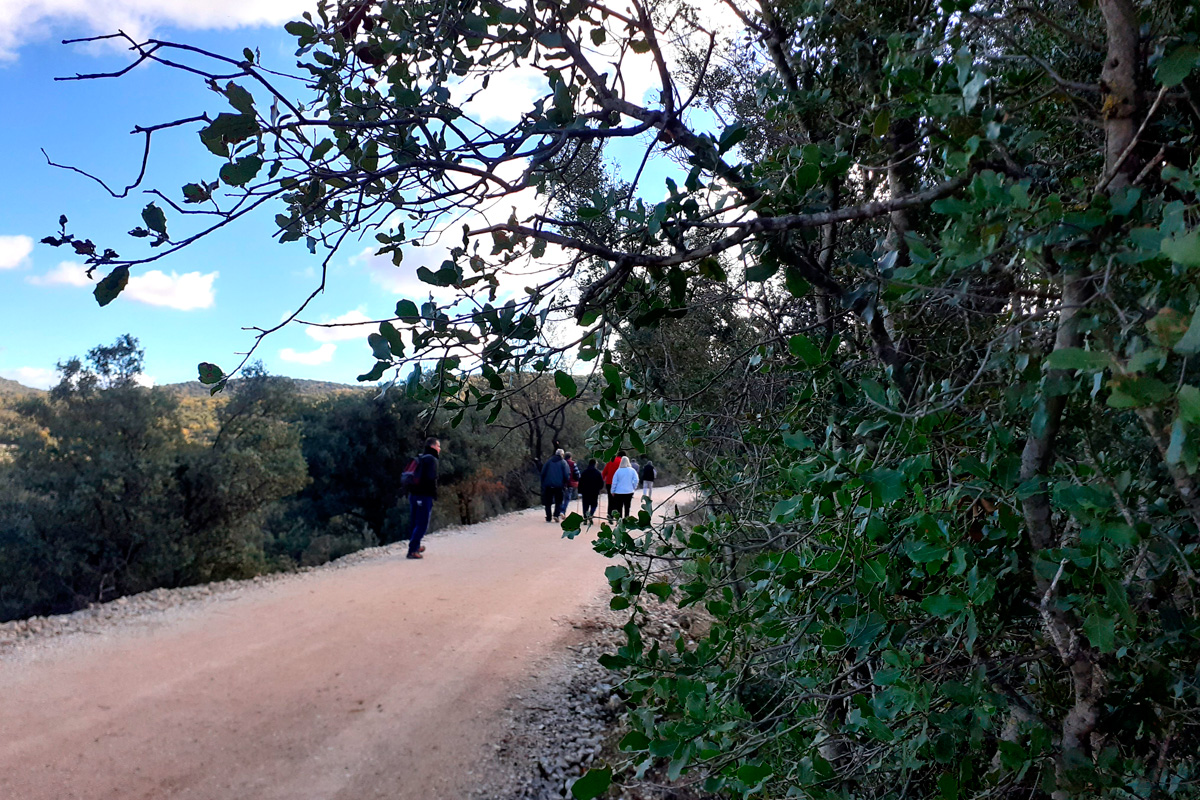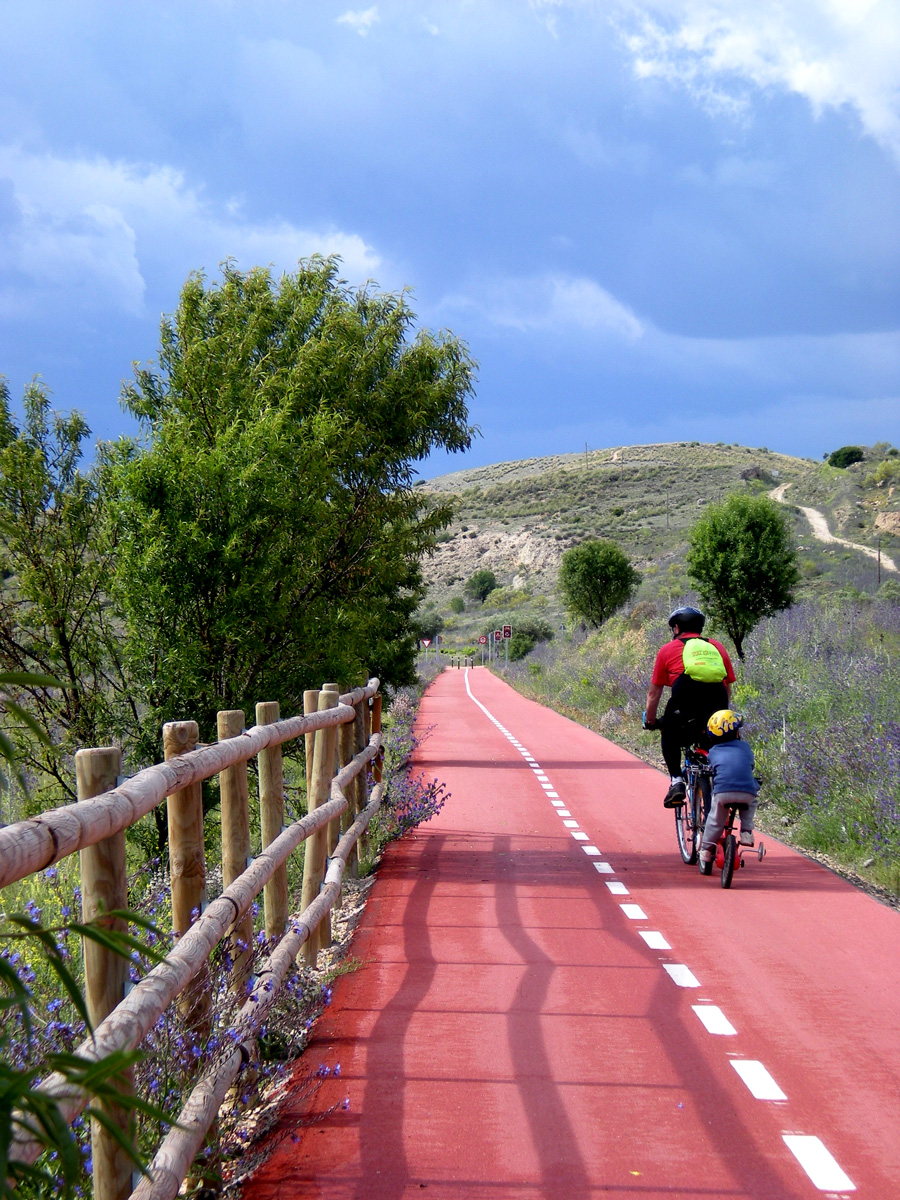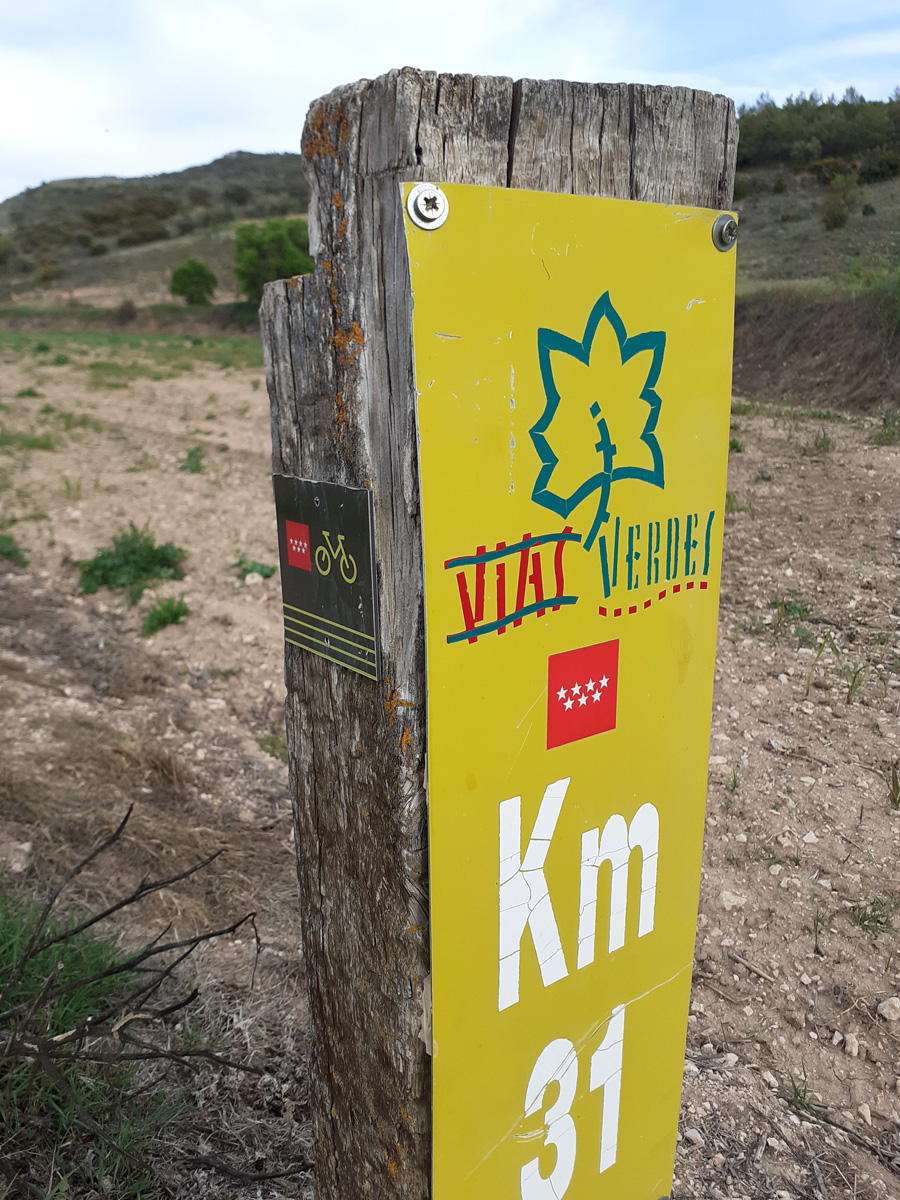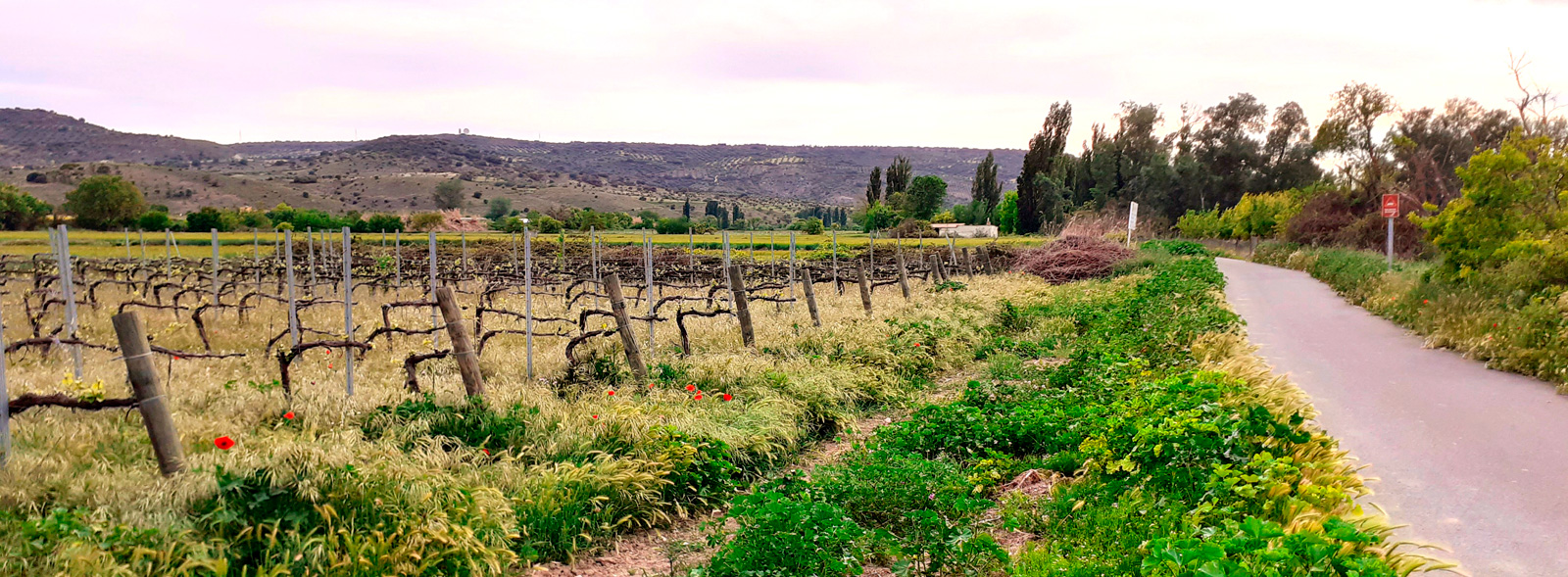Tajuña Greenway
Route Description
 The starting point is located in the town of Arganda del Rey, a site which can be reached from the city of Madrid by means of Metro line 9. The starting point (km 0) is located at Avenida del Ejercito, 200 m from the metro station; however, we recommend a visit to the Arganda Railway Museum, located 4.3 km from the Arganda Metro Station.
The starting point is located in the town of Arganda del Rey, a site which can be reached from the city of Madrid by means of Metro line 9. The starting point (km 0) is located at Avenida del Ejercito, 200 m from the metro station; however, we recommend a visit to the Arganda Railway Museum, located 4.3 km from the Arganda Metro Station.
Undoubtedly, visiting the small museum housed in the old station –which brings together an attractive legacy of vehicles and historical pieces, both from this line and others from the rest of Spain– and travelling on one of its historic trains is more than recommended. This railway site, managed by the Centro de Iniciativas Ferroviarias Vapor Madrid (C.I.F.V.M.), has made it possible to rehabilitate a 3.2 km section of the old Madrid-Alocén railway between La Poveda and Laguna del Campillo. It is the only historic railway line in operation in the Madrid Region, so let's go on a train trip! Narrow-gauge steam locomotives and small passenger cars travel along the surviving kilometres of the Tajuña railway for the enjoyment of its passengers.
After this recommended visit we will take the La Poveda bike path that takes advantage of the railway levelling work. Careful! Shortly after we cross the M-300 road (km 0.5). At km. 3.7 there is an intersection with Avenida de Madrid. Caution at crossings! And on the right we have the Tajuña Greenway.
After passing the industrial area of Arganda and the Hospital del Sureste, the greenway crosses under the A-3 motorway beginning a moderate ascent that ends in the area known as El Alto and then borders an imposing cement factory. From here, a pleasant descent brings us in front of one of the best viewpoints overlooking the Tajuña Valley shortly before reaching Morata de Tajuña. It is worth noting that between Arganda and Perales there is another interesting educational route called "the secrets of the Tajuña Greenway," where the vestiges related to one of the most decisive battles of the Spanish Civil War, the Battle of Jarama, fought in February 1937, are highlighted.
Morata de Tajuña and the dips
 From Morata de Tajuña (km 14) to Perales we continue along a greenway with a unique red surface, a detail that would make the description of the route almost unnecessary, since on the ground it is completely impossible to get lost, except perhaps at urban crossings. Thus, in order to depart from Morata after a first well-placed sign, the next crossroads may make us hesitate: we have to continue to the right and downhill and, from now on, straight on until we leave the village. The signage of CiclaMadrid and that of the Uclés route confirm our route at all times.
From Morata de Tajuña (km 14) to Perales we continue along a greenway with a unique red surface, a detail that would make the description of the route almost unnecessary, since on the ground it is completely impossible to get lost, except perhaps at urban crossings. Thus, in order to depart from Morata after a first well-placed sign, the next crossroads may make us hesitate: we have to continue to the right and downhill and, from now on, straight on until we leave the village. The signage of CiclaMadrid and that of the Uclés route confirm our route at all times.
We leave behind the houses of Morata de Tajuña and our route runs close to the M-308 road. This amusing section of about 7 km requires a little more effort since it features some dips that hinder the railway itinerary’s accessibility. These are due to the fact that the work of adaptation as a greenway did not completely restore the old railway level.
At km 20 you reach what was once a transfer station. These are the vestiges of Tajuña Station. Certainly, at present nothing remains of that station that connected with the trains that went up the branch to Chinchón and Colmenar de Oreja. So we will have to be attentive.
After crossing some striking trenches (absolutely vertical and with very beautiful gypsum outcrops) and crossing some more dips and ramps, we arrive at the first houses of Perales de Tajuña (km 23). At this urban crossing we will have to carefully cross a level junction with the busy M-308 road. On the other side of the junction we find the public school, built on the site where the Tajuña trains used to stop.
The Perales de Tajuña branch
In Perales the route has two alternatives: The first, partially crosses the town, following the M-506 road, then goes up towards the cemetery and from there it follow the old railway line that passes under the A-3 motorway. The second possibility is to follow a country track that surrounds Perales, passing by the swimming pools. This route, which is well marked, also takes us under the motorway, where we join the previous alternative.
After passing the A-3, we just have to continue a few metres to the right along the shoulder of the access road to the motorway to finally connect with the trails upgraded as a "greenway," although they are not those of the old railway that take us to Tielmes along the south bank of the river. It should be noted that this section is for shared traffic with cars that access the adjoining farms. In these parts the greenway runs about 3 km between orchards, crops and cornfields. At km 28 of the route, we will find the junction with the road from Tielmes to Villarejo de Salvanés.
The fertile plain of the Tielmes and Carabaña
 From this point, the town of Tielmes is about 300 m away, on the other side of the Tajuña. In this section, from Tielmes to Ambite, some stations still exist, having been restored for new uses while bearing witness to a romantic past. An example of this is Chávarri Station, where in the past the wagons were loaded with thousands of bottles of the salutary "Carabaña water."
From this point, the town of Tielmes is about 300 m away, on the other side of the Tajuña. In this section, from Tielmes to Ambite, some stations still exist, having been restored for new uses while bearing witness to a romantic past. An example of this is Chávarri Station, where in the past the wagons were loaded with thousands of bottles of the salutary "Carabaña water."
From the aforementioned crossroads, we will travel a few metres along the road, to the right, until we reach a track that, to the left, allows us to continue the route through the valley, passing by a small chapel bordered by shady areas that make it an excellent resting point. We must also mind the junction with the lonely road that connects Chávarri with Villarejo (km 33), the only point of possible danger on our journey through the valley.
At km 35 we reach the junction with the road from Carabaña to Brea de Tajo, in the vicinity of a bridge over the Tajuña, next to which stands one of the typical mills that marked this stretch of the river. In this place, located a few metres from Carabaña, we are offered an alternative to visit this secluded town in the southeast of Madrid, whose old train station is also still standing.
This new section has a pleasant surprise in store for us because at the point where we leave the side of the road to continue through the gentle meadows of the Tajuña River, we can connect with the Grand Tour CiclaMadrid (Stage 3) and with the 40-Day Train Greenway, a 14 km branch that leads us to Estremera among spectacular trenches, olive trees and fields.
On the Tajuña Greenway, we will continue parallel to the unrestored levelling of the aforementioned railway to reach Orusco de Tajuña (km 39), where we can make a stopover: the old train station still exists –although besie our route but in the village– and has been converted into an inn. In Orusco there was, during the Spanish Civil War, an interim railway junction with the 40-Day Train. From here, this route went up the moorland to reach, after a long journey, Torrejón de Ardoz. This route could also be upgraded as a greenway one day...
Setting aside future possibilities for now, the greenway currently continues upstream, crossing under the Orusco-Brea road. After passing under the asphalt, after a short time, we find the original route of the Tajuña railway again, which we will not leave until the end of the route in Ambite. This is one of the greenway’s most pleasant sections: we will pass under small overpasses, between groves, remains of old gypsum mines and, in some cases, over sections that are almost like cliffs above the river.
Little by little we are approaching the end of the route, Ambite (km 48). The greenway crosses a dense pine forest with a small recreational area. A beautiful place to contemplate this small town, the last in the Madrid Region before entering the neighbouring province of Guadalajara. Thus, we arrive at the old station, which houses an outdoor municipal swimming pool. It is a facility that, like the greenway, is designed for everyone: it has access for people with reduced mobility and features an elevator that facilitates immersion in the water. And, as if this were not enough incentive, the old passenger building houses a bar where you can recharge your batteries.
Towards the province of Guadalajara
 En Ambite we come across our first point of interest, the Vega del Tajuña Nature Centre, with its permanent exhibition featuring the highlights of the region's ecosystems, as well as a bike and tricycle rental service.
En Ambite we come across our first point of interest, the Vega del Tajuña Nature Centre, with its permanent exhibition featuring the highlights of the region's ecosystems, as well as a bike and tricycle rental service.
On compacted earth and after a first slope to reach the level of the railway platform, the greenway continues for 3 km, from the surroundings of the fertile plain of the Tajuña River, ascending little by little up the slope of the valley.
The second part of the itinerary is of greater interest since it goes through the area's most representative ecosystem, Mediterranean scrubland, with holm oak as the dominant tree species. The landscape also features some olive groves.
A little further on we will come across a flyover above the greenway, which was used in the past to cross the railway. We can still see the ballast (stone placed at the base of the rails), which the greenway now goes around. At the end of the Ambite section there is a viaduct that enabled the train to pass over the Perdiz Ravine. From this considerable height, we can contemplate spectacular scenery featuring the Tajuña River lowlands. The small riverside forest, in which black poplars stand out, dominates the valley floor, surrounded by mainly cereal crops.
The greenway in the Madrid Region ends here, but you can continue for more than 12 km in the neighbouring province of Guadalajara as far as Pozo de Almoguera, if you want to continue enjoying this old railway. And, hopefully, someday this Greenway will manage to reach the banks of the Tagus River in Entrepeñas.
But at the moment you have no more and no less than 68 km of continuous Greenway (plus another 14 km of the 40-Day Train Greenway) to explore the regions of Madrid and Castile-La Mancha. Discover them!
* This greenway was implemented by the Madrid Region, Ambite Town Council, FADETA Rural Development Group and Móndejar Town Council.



